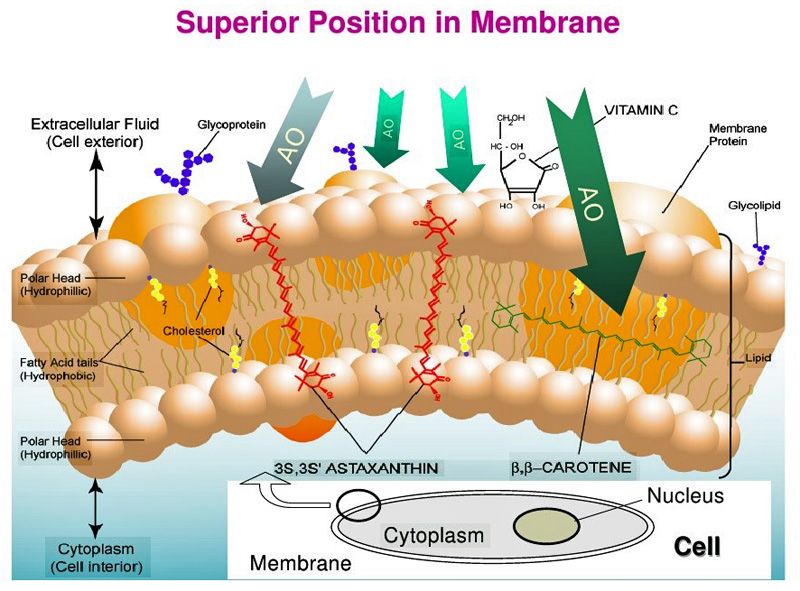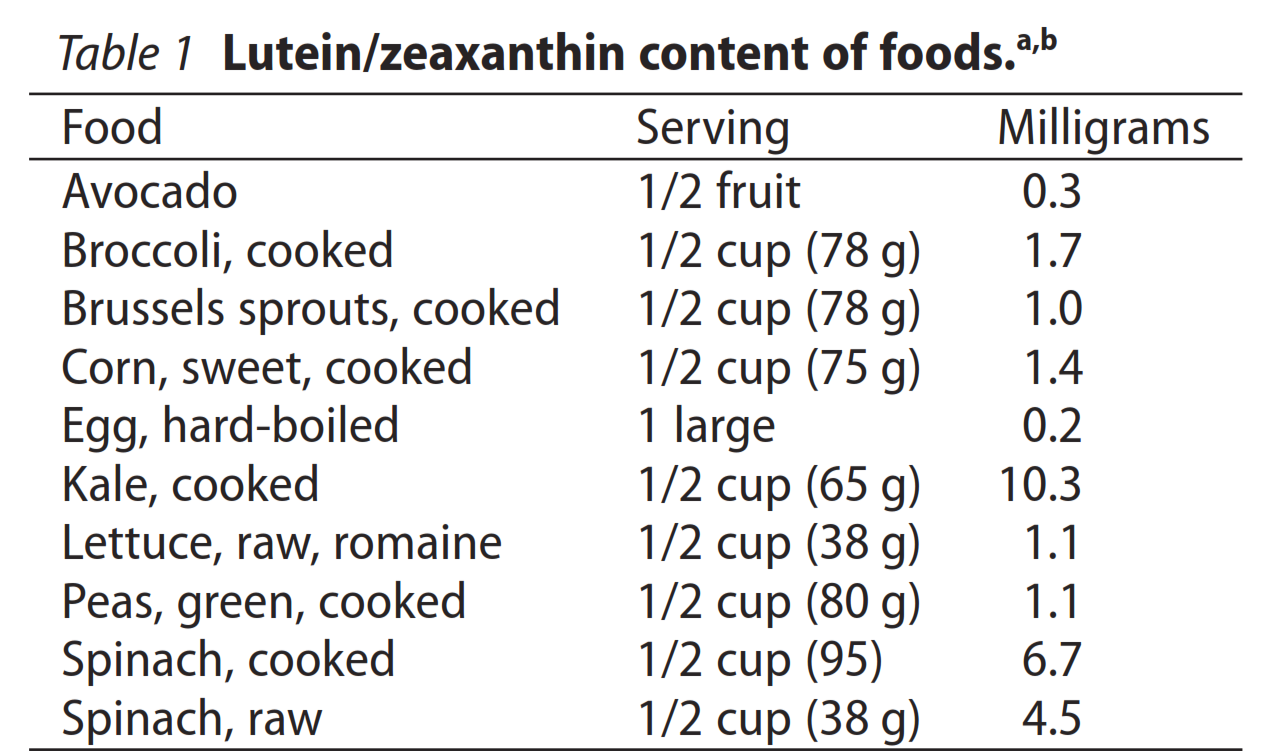Is lutein a Magic Bullet for cognition?
-
If we summarize:
Lutein and zeaxanthin in the eye (6 mg).
Vitamin E and b-carotene for vessel membranes (2 x 4mg) Vit E inside, B-carotene outside. (1)
Mainly lutein and carotenoid for the brain (+ lycopene).
Lycopene for prostate.
Note: I won’t take any supplement for B-carotene: No need and could be problematic if you smoke.

Useful info (in French, translator needed):- Vit E et peroxydation des membranes
http://mirzoune-ciboulette.forumactif.org/t642-vitamine-e-et-peroxydation-des-membranes#5645
Caution: - For vit E: at least 2 tocos. Too much of a good thing is bad.
- Polyphenols modify the microbiota. In cure, ok.
- Vit E et peroxydation des membranes
-
Eat lots of eggs daily
-
@bio3nergetic Raw or boiled?
-
@PrinceTrebata Egg yolks raw, whites very well cooked.
-
@PrinceTrebata said in Is lutein a Magic Bullet for cognition?:
@bio3nergetic Raw or boiled?
This question is relevant to vegetable sources of lutein as well.
Peatbot: Green leafy vegetables can be healthy, but there are some considerations to keep in mind. They are important sources of magnesium and vitamin K, and when cooked, they can provide a favorable balance of minerals such as magnesium, potassium, and calcium. Cooking is important because raw greens contain cellulose that encloses nutrients, making them inaccessible to our enzymes. Cooking breaks down the cellulose, making the nutrients more digestible.
However, raw leafy greens contain defensive chemicals that can block digestive enzymes, which can be problematic for some people. Cooking these vegetables thoroughly can help break down these toxins. Additionally, some leafy greens, like spinach, contain oxalic acid, which can interfere with calcium absorption.
Overall, while green leafy vegetables can be a healthy part of the diet, cooking them can enhance their nutritional benefits and reduce potential digestive issues.
-
@DavidPS said in Is lutein a Magic Bullet for cognition?:
Role of lutein and zeaxanthin in visual and cognitive function throughout the lifespan (2014)
While there is no recommended dietary intake for **lutein, intakes of approximately 6 mg/d have been associated with a decreased risk of age-related macular degeneration. The current intakes of lutein among adults fall well below this level, with average intakes of <2 mg/d for both men and women. Only men in the 99th percentile of lutein/zeaxanthin intake and women in the 95th percentile meet the dietary intakes that have been related to decreased risk of age-related macular degeneration. Therefore, there is a dietary gap between the intakes believed to be of benefit and the intakes being consumed. Increasing dietary lutein intake through healthy food choices could be an important public health strategy for reducing the risk of visual or cognitive impairment.
If a carnivore who wants to mono source all of their lutein from eggs, it looks like 30 eggs per day for the rest of their life would keep them in the zone (>6 mg/d).

-
@DavidPS another W for eggs
-
@DavidPS That's for hard boiled though I'm pretty sure high temps decrease lutein
-
Typical loss of Lutein+Zeaxanthin (as compared to raw food): 5% Freeze, 50% Dry, 25% Cook, 35% Cook+Drain, 10% Reheat.
Source: Nutritional Effects of Food Processing
http://nutritiondata.self.com/topics/processing
Freezing, Drying, Cooking, and Reheating.
Note: the results are often variable. -
@LucH - thank you, this is very useful information.
-
@asterbolic - A 25-35% reduction in lutein will still require lot of raw eggs every day to meet the 6 mg/d level. Only men in the 99th percentile of lutein/zeaxanthin intake and women in the 95th percentile meet the dietary intakes that have been related to decreased risk of age-related macular degeneration and cognitive impairment.
There are several safety issues with eating raw eggs. Is Eating Raw Eggs Safe and Healthy?
Since raw eggs deplete biotin, see also
Is Biotin as Good as Advertised for Your Hair Loss? -
 D DavidPS referenced this topic on
D DavidPS referenced this topic on
-
A 2024 review article - Beyond food colouring: Lutein-food fortification to enhance health
-
 D DavidPS referenced this topic on
D DavidPS referenced this topic on
-
@LucH said in Is lutein a Magic Bullet for cognition?:
Typical loss of Lutein+Zeaxanthin (as compared to raw food): 5% Freeze, 50% Dry, 25% Cook, 35% Cook+Drain, 10% Reheat.
Source: Nutritional Effects of Food Processing
http://nutritiondata.self.com/topics/processing
Freezing, Drying, Cooking, and Reheating.
Note: the results are often variable.Thanks for the info, though this contradicts what @DavidPS posted above, where cooked spinach has more lutein than raw.
-
@Mossy said in Is lutein a Magic Bullet for cognition?:
Thanks for the info, though this contradicts what @DavidPS posted above, where cooked spinach has more lutein than raw.
I suppose it varies from different studies and what is found in the ground.
-
@LucH said in Is lutein a Magic Bullet for cognition?:
@Mossy said in Is lutein a Magic Bullet for cognition?:
Thanks for the info, though this contradicts what @DavidPS posted above, where cooked spinach has more lutein than raw.
I suppose it varies from different studies and what is found in the ground.
Yes. I'm also considering that the 1/2 cup is volume, where cooked spinach shrinks, hence the higher weight in grams to the right.
-
-
@DavidPS and others
Remind that when eating spinach, you need a lot of calcium and citrates because it's very high in oxalates. +/ 600 mg for 100 gr.
The body can only manage 50 mg per day; 150-200 mg is often taken but what is higher than 50 mg is taken away in urine (citrate) and in stools (calcium).
I never take more than 200-250 mg Ca element. When I eat spinach, I mix it with my meal (potato, spinach or broccoli, 1 egg (or egg yolk), a small onion lightly cooked, and spices) + 4 oz. beef (100-110 g).
I take then once 1000 mg citrate calcium tablet (big one) if I haven't got enough calcium for the day (1200 instead of 850 mg Ca) or I take 2 doses (2.5 g x 2) potassium citrate powder.
The optimal minimal ratio Ca / Ox is 1/3. So in theory 200 mg Ca per 100 gr spinach (600 mg oxalates).
Mind for lithiasis if you don't manage well. And when you don't balance well with other minerals, if deficit in base, you're going to excite PTH and bone remodeling.
Edit: 200 mg Ca element is not the same as 200 mg calcium citrate. There is +/ 30 % Ca element in Ca citrate.
Note: Calcium to magnesium ratios <1.7 and >2.8 can be detrimental, and optimal ratios may be ∼2.0 for bone mineral density.
Taking calcium alone does not stop or even slow bone loss and does not prevent osteoporosis according to recent studies. Need for Mg element 480 mg target. -
Useful info
Interactions between vitamins A, D, E, and K
http://www.westonaprice.org/health-topics/abcs-of-nutrition/nutritional-adjuncts-to-the-fat-soluble-vitamins/
Summary
• Vitamins A, D, and K2 interact synergistically to support immune health, provide for adequate growth, support strong bones and teeth, and protect soft tissues from calcification.
• Magnesium is required for the production of all proteins, including those that interact with vitamins A and D.
• Vitamins A and D support the absorption of zinc and zinc supports the absorption of all the fat-soluble vitamins.
• Many of the proteins involved in vitamin A metabolism and the receptors for both vitamins A and D only function correctly in the presence of zinc.
• Dietary fat is necessary for the absorption of fat-soluble vitamins.
• Vitamin K2 activates proteins by adding carbon dioxide to them. We can increase carbon dioxide production by consuming carbohydrates, exercising, and maintaining robust thyroid status.
• The fat-soluble vitamins thus interact not only with each other, but with other nutrients and metabolic factors as well. This level of complexity should urge us to exercise caution when interpreting scientific research, and to cooperate with the wisdom of nature by obtaining vitamins through nutrient-dense foods.
Throughout the twentieth century, we viewed the fat-soluble vitamins in isolation from one another. Researchers relegated vitamin K to blood coagulation, and ignored vitamin K2 entirely because it is present in such small quantities in the diet. Vitamins A and D each fell in and out of favour, the popularity of one always rising at the expense of the other. Ignoring the forest to study one tree at a time, the concept of synergy eluded us.
In order to truly understand the fat-soluble vitamins, however, we must understand that vitamins A, D, and K cooperate synergistically not only with each other, but also with essential minerals like magnesium and zinc, with dietary fat, and with key metabolic factors like carbon dioxide and thyroid hormone.
Link: Bone remodeling and modeling (role of cells osteoclasts for resorption; cells osteoblasts have the role to remodel new bones to repair damage)
Youtube Video -
Useful info
Interaction between fat-soluble vitamins A D K
Key ideas
Nutritionists talk about vitamin K as if there were only one type!
We know the role of vitamin K1 (phytomenadione) for its role in coagulation. It is mainly found in green vegetables.
Vitamin K2 (menaquinone) is less well known and has no RDA recommended by health authorities!
We can convert K1 into K2 but it is random and notoriously insufficient.
K2 plays a key role in the activation of hormones that regulate calcium metabolism: osteocalcin, which is involved in the mineralization of bone matrix, and matrix Gla protein (MGP), which protects soft tissues against calcification.
The role of vitamin K2 is not limited to these functions alone. Here, it is much more than a co-factor because vitamin K2 is the substance that allows dependent proteins A and D to activate/come to life. While vitamins A and D act as signaling molecules, telling cells to produce certain proteins, vitamin K2 activates these proteins, giving them the physical ability to bind calcium.
If more details wanted:
https://mirzoune-ciboulette.forumactif.org/t127-interaction-entre-les-vitamines-liposolubles#889
See second post for the original article in English.